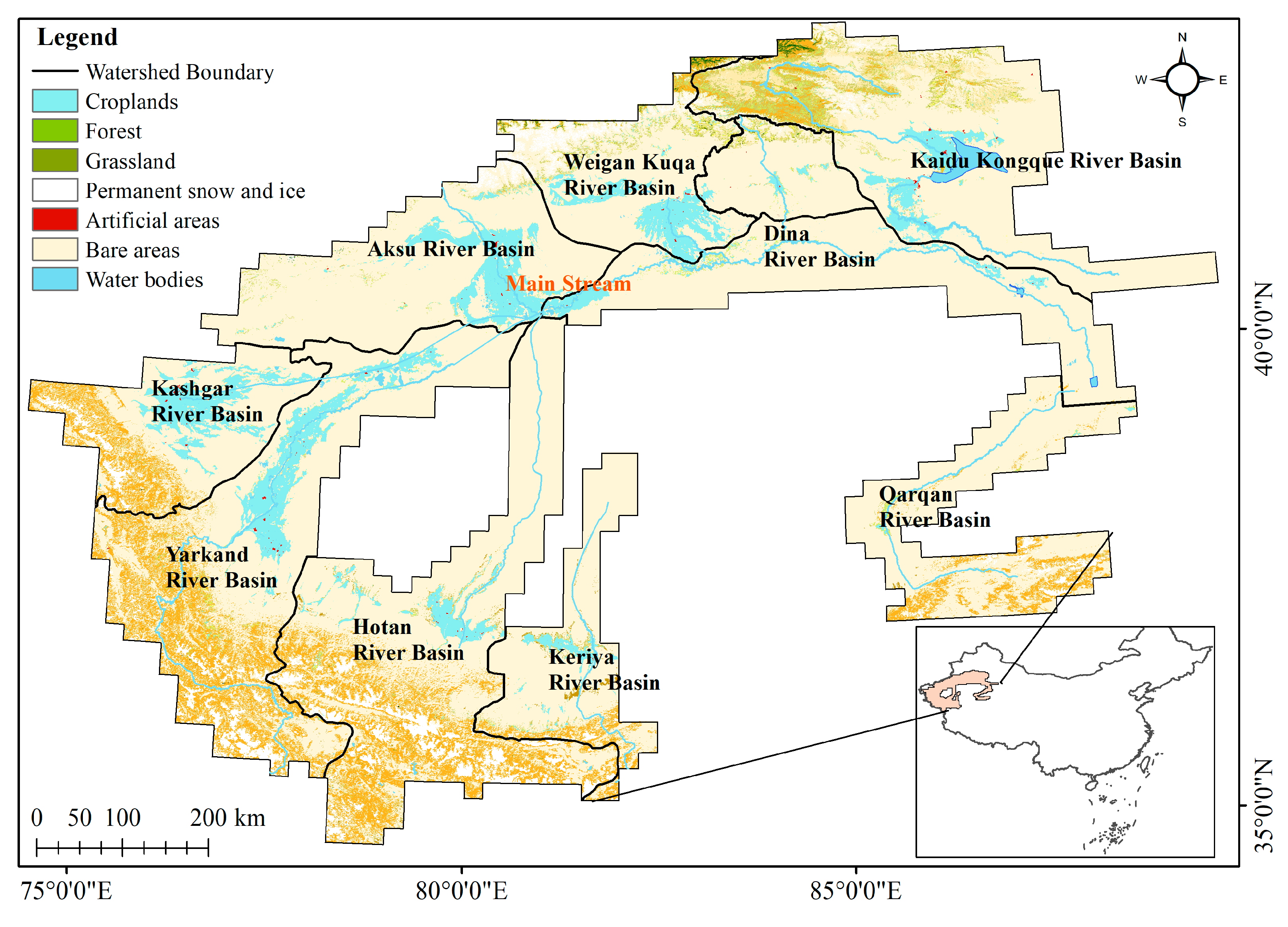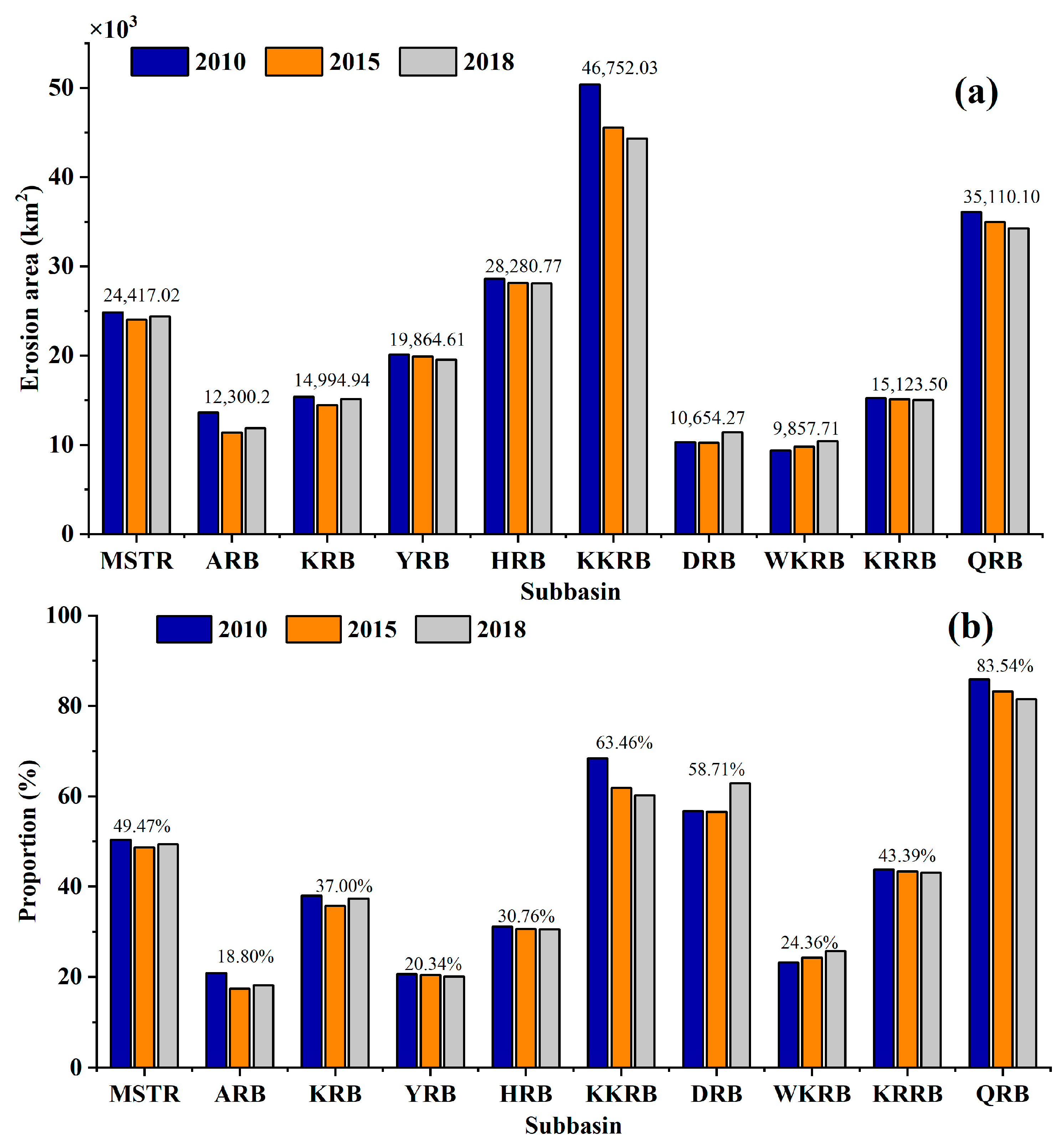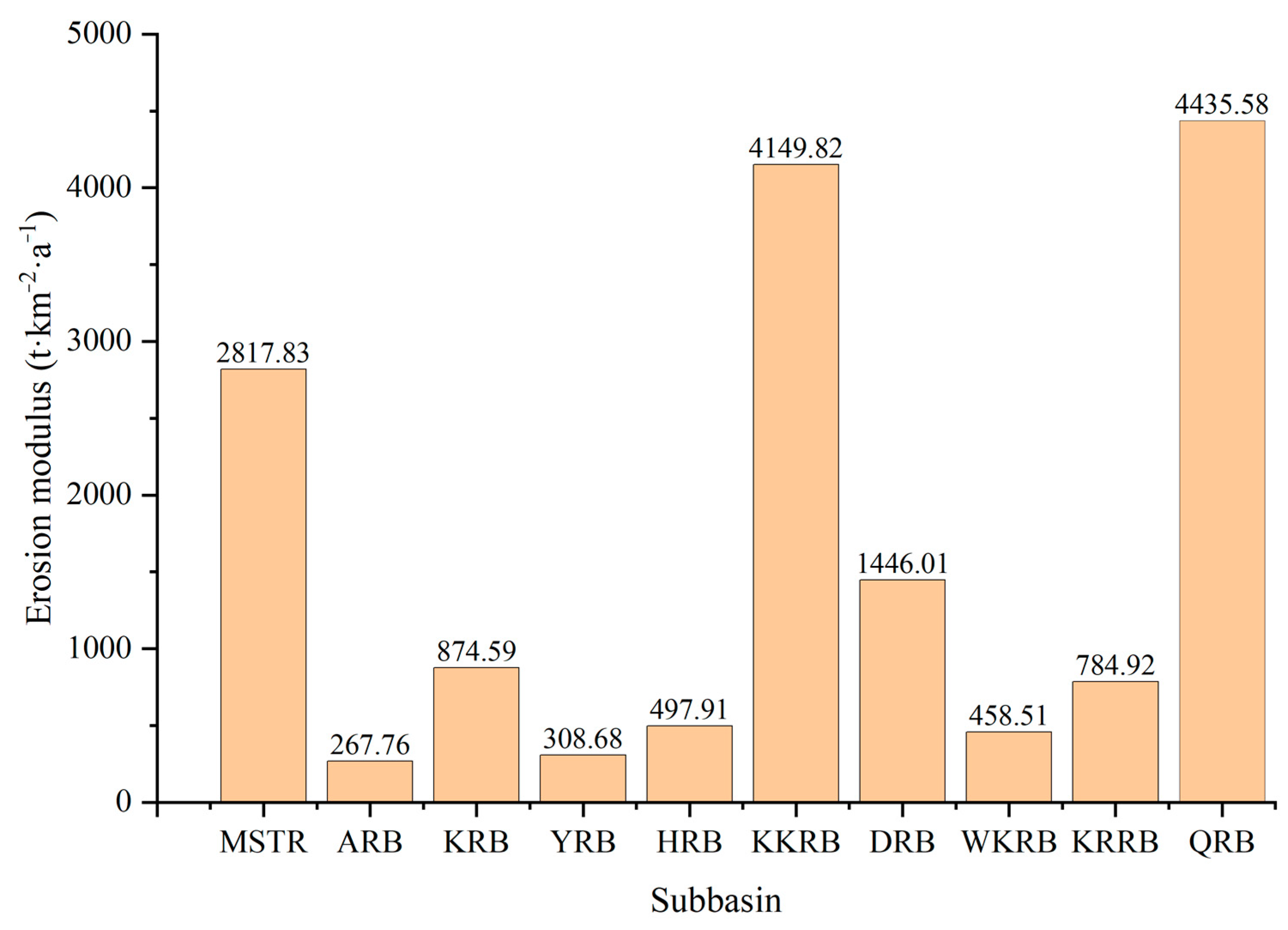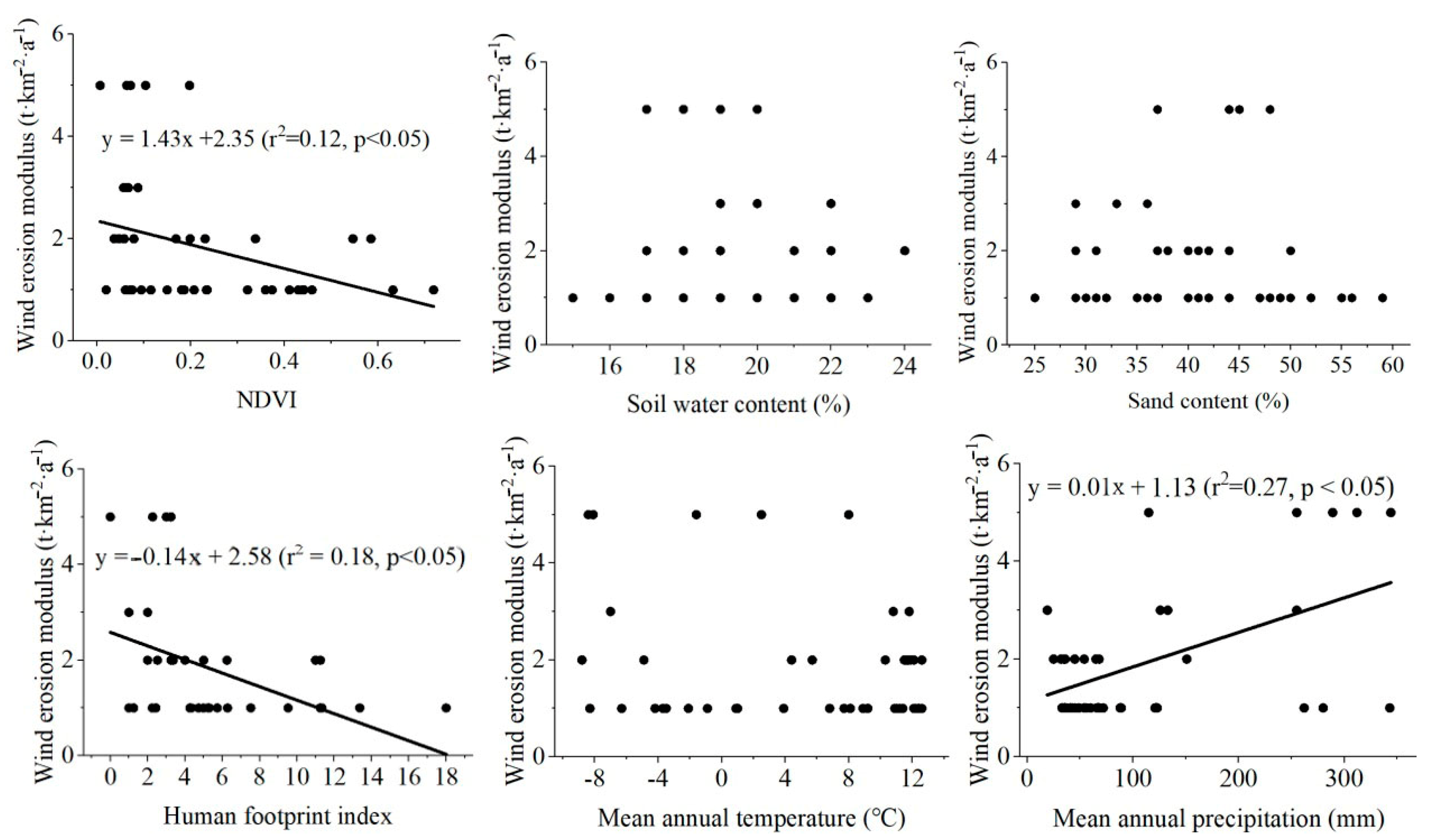Spatiotemporal Variation in Wind Erosion in Tarim River Basin from 2010 to 2018
Abstract
:1. Introduction
2. Materials and Methods
2.1. Study Area
2.2. Data Sources
2.3. Soil Wind Erosion Model
2.4. Classification of Soil Wind Erosion Intensity
2.5. Statistical Analysis
3. Results
3.1. Spatial Variation in Soil Wind Erosion
3.2. Multitemporal Variation of Soil Wind Erosion
3.3. The Impact of Environmental Variables on Wind Erosion
4. Discussions
4.1. The Reliability of Our Method
4.2. The Drivers of Soil Wind Erosion in the Tarim River Basin
5. Conclusions
Author Contributions
Funding
Data Availability Statement
Acknowledgments
Conflicts of Interest
References
- Chepil, W. Dynamics of wind erosion: I. Nature of movement of soil by wind. Soil Sci. 1945, 60, 305–320. [Google Scholar] [CrossRef]
- Lyles, L. Possible effects of wind erosion on soil productivity. J. Soil Water Conserv. 1975, 30, 279–283. [Google Scholar]
- Wu, Z.; Wang, M.; Zhang, H.; Du, Z. Vegetation and soil wind erosion dynamics of sandstorm control programs in the agro-pastoral transitional zone of northern China. Front. Earth Sci. 2019, 13, 430–443. [Google Scholar] [CrossRef]
- Bartkowski, B.; Schepanski, K.; Bredenbeck, S.; Müller, B. Wind erosion in european agricultural landscapes: More than physics. People Nat. 2023, 5, 34–44. [Google Scholar] [CrossRef]
- Woodruff, N.P.; Siddoway, F. A wind erosion equation. Soil Sci. Soc. Am. J. 1965, 29, 602–608. [Google Scholar] [CrossRef]
- Wagner, L.E. A history of wind erosion prediction models in the united states department of agriculture: The wind erosion prediction system (weps). Aeolian Res. 2013, 10, 9–24. [Google Scholar] [CrossRef]
- Bocharov, A. A Description of Devices Used in the Study of Wind Erosion of Soils; AA Balkema: Rotterdam, The Netherlands, 1984. [Google Scholar]
- Wang, F.; Pan, X.; Wang, D.; Shen, C.; Lu, Q. Combating desertification in China: Past, present and future. Land Use Policy 2013, 31, 311–313. [Google Scholar] [CrossRef]
- Yang, X.; Zhu, Z.; Jaekel, D.; Owen, L.; Han, J. Late quaternary palaeoenvironment change and landscape evolution along the keriya river, xinjiang, China: The relationship between high mountain glaciation and landscape evolution in foreland desert regions. Quat. Int. 2002, 97, 155–166. [Google Scholar] [CrossRef]
- Dong, Z.; Li, S.; Zhao, Y.; Lei, J.; Wang, Y.; Li, C. Stable oxygen-hydrogen isotopes reveal water use strategies of tamarix taklamakanensis in the Taklimakan desert, China. J. Arid Land 2020, 12, 115–129. [Google Scholar] [CrossRef]
- Hao, X.-M.; Li, C.; Guo, B.; Ma, J.-X.; Ayup, M.; Chen, Z.-S. Dew formation and its long-term trend in a desert riparian forest ecosystem on the eastern edge of the taklimakan desert in China. J. Hydrol. 2012, 472, 90–98. [Google Scholar] [CrossRef]
- Chen, Z.; Cui, H.; Wu, P.; Zhao, Y.; Sun, Y. Study on the optimal intercropping width to control wind erosion in north China. Soil Tillage Res. 2010, 110, 230–235. [Google Scholar] [CrossRef]
- Du, H.; Zuo, X.; Li, S.; Wang, T.; Xue, X. Wind erosion changes induced by different grazing intensities in the desert steppe, northern China. Agric. Ecosyst. Environ. 2019, 274, 1–13. [Google Scholar] [CrossRef]
- Li, D.; Xu, E.; Zhang, H. Influence of ecological land change on wind erosion prevention service in arid area of northwest China from 1990 to 2015. Ecol. Indic. 2020, 117, 106686. [Google Scholar] [CrossRef]
- Chi, W.; Zhao, Y.; Kuang, W.; He, H. Impacts of anthropogenic land use/cover changes on soil wind erosion in China. Sci. Total Environ. 2019, 668, 204–215. [Google Scholar] [CrossRef] [PubMed]
- Du, H.; Wang, T.; Xue, X. Potential wind erosion rate response to climate and land-use changes in the watershed of the ningxia–inner mongolia reach of the yellow river, China, 1986–2013. Earth Surf. Process. Landf. 2017, 42, 1923–1937. [Google Scholar] [CrossRef]
- Chen, C.; Zhao, G.; Zhang, Y.; Bai, Y.; Tian, P.; Mu, X.; Tian, X. Linkages between soil erosion and long-term changes of landscape pattern in a small watershed on the chinese loess plateau. CATENA 2023, 220, 106659. [Google Scholar] [CrossRef]
- Dai, T.; Wang, L.; Li, T.; Qiu, P.; Wang, J. Study on the characteristics of soil erosion in the black soil area of northeast China under natural rainfall conditions: The case of sunjiagou small watershed. Sustainability 2022, 14, 8284. [Google Scholar] [CrossRef]
- Shi, Z.; Cai, C.; Ding, S.; Wang, T.; Chow, T. Soil conservation planning at the small watershed level using rusle with gis: A case study in the three gorge area of China. CATENA 2004, 55, 33–48. [Google Scholar] [CrossRef]
- Chen, J.; Xiao, H.; Li, Z.; Liu, C.; Wang, D.; Wang, L.; Tang, C. Threshold effects of vegetation coverage on soil erosion control in small watersheds of the red soil hilly region in China. Ecol. Eng. 2019, 132, 109–114. [Google Scholar] [CrossRef]
- Zhang, Z.; Sheng, L.; Yang, J.; Chen, X.-A.; Kong, L.; Wagan, B. Effects of land use and slope gradient on soil erosion in a red soil hilly watershed of southern China. Sustainability 2015, 7, 14309–14325. [Google Scholar] [CrossRef]
- Wei, J.-B.; Xiao, D.-N.; Zeng, H.; Fu, Y.-K. Spatial variability of soil properties in relation to land use and topography in a typical small watershed of the black soil region, northeastern China. Environ. Geol. 2008, 53, 1663–1672. [Google Scholar] [CrossRef]
- Sepuru, T.K.; Dube, T. An appraisal on the progress of remote sensing applications in soil erosion mapping and monitoring. Remote Sens. Appl. Soc. Environ. 2018, 9, 1–9. [Google Scholar] [CrossRef]
- King, C.; Baghdadi, N.; Lecomte, V.; Cerdan, O. The application of remote-sensing data to monitoring and modelling of soil erosion. CATENA 2005, 62, 79–93. [Google Scholar] [CrossRef]
- García-Ruiz, J.M.; Beguería, S.; Nadal-Romero, E.; González-Hidalgo, J.C.; Lana-Renault, N.; Sanjuán, Y. A meta-analysis of soil erosion rates across the world. Geomorphology 2015, 239, 160–173. [Google Scholar] [CrossRef]
- Lal, R. Soil Erosion Research Methods; St. Lucie Press: Delray Beach, FL, USA, 1994. [Google Scholar]
- Krishna Bahadur, K. Mapping soil erosion susceptibility using remote sensing and gis: A case of the upper nam wa watershed, nan province, thailand. Environ. Geol. 2009, 57, 695–705. [Google Scholar] [CrossRef]
- Chen, T.; Niu, R.-q.; Li, P.-x.; Zhang, L.-p.; Du, B. Regional soil erosion risk mapping using rusle, gis, and remote sensing: A case study in miyun watershed, north China. Environ. Earth Sci. 2011, 63, 533–541. [Google Scholar] [CrossRef]
- Weifeng, Z.; Bingfang, W. Assessment of soil erosion and sediment delivery ratio using remote sensing and gis: A case study of upstream chaobaihe river catchment, north China. Int. J. Sediment Res. 2008, 23, 167–173. [Google Scholar]
- Teng, H.-F.; Jie, H.; Yue, Z.; Zhou, L.-Q.; Zhou, S. Modelling and mapping soil erosion potential in China. J. Integr. Agric. 2019, 18, 251–264. [Google Scholar] [CrossRef]
- Wang, X.; Zhao, X.; Zhang, Z.; Yi, L.; Zuo, L.; Wen, Q.; Liu, F.; Xu, J.; Hu, S.; Liu, B. Assessment of soil erosion change and its relationships with land use/cover change in China from the end of the 1980s to 2010. CATENA 2016, 137, 256–268. [Google Scholar] [CrossRef]
- Yang, X.; Zhang, K.; Jia, B.; Ci, L. Desertification assessment in China: An overview. J. Arid Environ. 2005, 63, 517–531. [Google Scholar] [CrossRef]
- Batista, P.V.; Davies, J.; Silva, M.L.; Quinton, J.N. On the evaluation of soil erosion models: Are we doing enough? Earth-Sci. Rev. 2019, 197, 102898. [Google Scholar] [CrossRef]
- Funk, R.; Skidmore, E.L.; Hagen, L.J. Comparison of wind erosion measurements in germany with simulated soil losses by weps. Environ. Model. Softw. 2004, 19, 177–183. [Google Scholar] [CrossRef]
- Shen, Z.; Gong, Y.; Li, Y.; Hong, Q.; Xu, L.; Liu, R. A comparison of wepp and swat for modeling soil erosion of the zhangjiachong watershed in the three gorges reservoir area. Agric. Water Manag. 2009, 96, 1435–1442. [Google Scholar] [CrossRef]
- Tao, H.; Gemmer, M.; Bai, Y.; Su, B.; Mao, W. Trends of streamflow in the tarim river basin during the past 50 years: Human impact or climate change? J. Hydrol. 2011, 400, 1–9. [Google Scholar] [CrossRef]
- Xu, Z.; Chen, Y.; Li, J. Impact of climate change on water resources in the tarim river basin. Water Resour. Manage. 2004, 18, 439–458. [Google Scholar] [CrossRef]
- Xu, Z.; Liu, Z.; Fu, G.; Chen, Y. Trends of major hydroclimatic variables in the tarim river basin during the past 50 years. J. Arid Environ. 2010, 74, 256–267. [Google Scholar] [CrossRef]
- GB/T 21010-2007; Current Land Use Classification. China Standard Press: Beijing, China, 2007.
- SL190-2007; Standards for Classification and Gradation of SOIL Erosion. Ministry of Water Resources of the People’s Republic of China: Beijing, China, 2008.
- Pi, H.; Sharratt, B.; Lei, J. Wind erosion and dust emissions in central asia: Spatiotemporal simulations in a typical dust year. Earth Surf. Process. Landf. 2019, 44, 521–534. [Google Scholar] [CrossRef]
- Kang, Y. Study on Soil Erosion Observation and Simulation in Taklimakan Desert. Master’s Thesis, Xinjiang Normal University, Urumqi, China, 2018. [Google Scholar]
- Chi, W.; Wang, Y.; Lou, Y.; Na, Y.; Luo, Q. Effect of land use/cover change on soil wind erosion in the yellow river basin since the 1990s. Sustainability 2022, 14, 12930. [Google Scholar] [CrossRef]
- Ali, K.F.; De Boer, D.H. Spatially distributed erosion and sediment yield modeling in the upper indus river basin. Water Resour. Res. 2010, 46, W08504. [Google Scholar] [CrossRef]
- Uddin, K.; Murthy, M.; Wahid, S.M.; Matin, M.A. Estimation of soil erosion dynamics in the koshi basin using gis and remote sensing to assess priority areas for conservation. PLoS ONE 2016, 11, e0150494. [Google Scholar] [CrossRef] [PubMed]
- Biswas, S.S.; Pani, P. Estimation of soil erosion using rusle and gis techniques: A case study of barakar river basin, jharkhand, india. Model. Earth Syst. Environ. 2015, 1, 1–13. [Google Scholar] [CrossRef]
- Wu, G.L.; Liu, Y.F.; Cui, Z.; Liu, Y.; Shi, Z.H.; Yin, R.; Kardol, P. Trade-off between vegetation type, soil erosion control and surface water in global semi-arid regions: A meta-analysis. J. Appl. Ecol. 2020, 57, 875–885. [Google Scholar] [CrossRef]
- Abdullah, M.; Feagin, R.; Musawi, L. The use of spatial empirical models to estimate soil erosion in arid ecosystems. Environ. Monit. Assess. 2017, 189, 1–17. [Google Scholar] [CrossRef] [PubMed]






| Type | The Data Sources |
|---|---|
| Wind force factor | Based on the observation data in the monitoring area from 1991 to 2018 |
| Topsoil moisture factor | Based on AMSR-E Level2A brightness temperature data inversion in 2010, 2015, and 2018 |
| Roughness factor | Field survey data in 2018 and 2019 as well as existing data and the literature in the previous period (from 2006 to 2016) |
| Vegetation coverage | Remote-sensing-derived monthly mean FVC data from 2008–2010, 2013–2015, and 2016–2018 |
| Land cover | National basic survey program |
| Topography | The Shuttle Radar Topography Mission |
| Erosion Intensity | Erosion Area (km2) | Percentage of Total Erosion Area (%) | ||||
|---|---|---|---|---|---|---|
| 2010 | 2015 | 2018 | 2010 | 2015 | 2018 | |
| Light (and micro) | 154,015.92 | 144,778.67 | 144,962.37 | 68.75 | 67.78 | 67.60 |
| Medium | 28,137.31 | 28,494.36 | 28,477.82 | 12.56 | 13.34 | 13.28 |
| Strong | 15,457.60 | 15,998.71 | 16,983.76 | 6.90 | 7.49 | 7.92 |
| Extremely strong | 16,532.91 | 15,656.94 | 15,161.01 | 7.38 | 7.33 | 7.07 |
| Severe | 9879.42 | 8672.20 | 8856.43 | 4.41 | 4.06 | 4.13 |
| Total erosion area | 224,023.16 | 213,600.87 | 214,441.38 | 100 | 100 | 100 |
Disclaimer/Publisher’s Note: The statements, opinions and data contained in all publications are solely those of the individual author(s) and contributor(s) and not of MDPI and/or the editor(s). MDPI and/or the editor(s) disclaim responsibility for any injury to people or property resulting from any ideas, methods, instructions or products referred to in the content. |
© 2024 by the authors. Licensee MDPI, Basel, Switzerland. This article is an open access article distributed under the terms and conditions of the Creative Commons Attribution (CC BY) license (https://creativecommons.org/licenses/by/4.0/).
Share and Cite
Zhang, Q.; Gu, F.; Zhang, S.; Chen, X.; Ding, X.; Xu, Z. Spatiotemporal Variation in Wind Erosion in Tarim River Basin from 2010 to 2018. Land 2024, 13, 330. https://doi.org/10.3390/land13030330
Zhang Q, Gu F, Zhang S, Chen X, Ding X, Xu Z. Spatiotemporal Variation in Wind Erosion in Tarim River Basin from 2010 to 2018. Land. 2024; 13(3):330. https://doi.org/10.3390/land13030330
Chicago/Turabian StyleZhang, Qinqin, Fang Gu, Sicong Zhang, Xuehua Chen, Xue Ding, and Zhonglin Xu. 2024. "Spatiotemporal Variation in Wind Erosion in Tarim River Basin from 2010 to 2018" Land 13, no. 3: 330. https://doi.org/10.3390/land13030330





